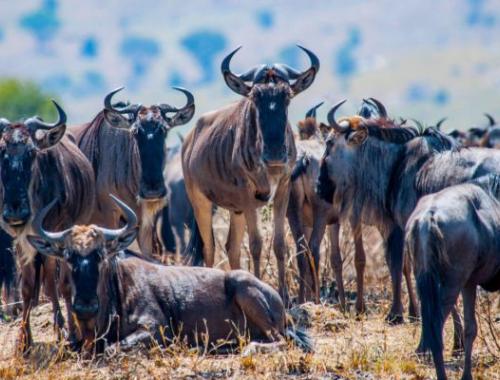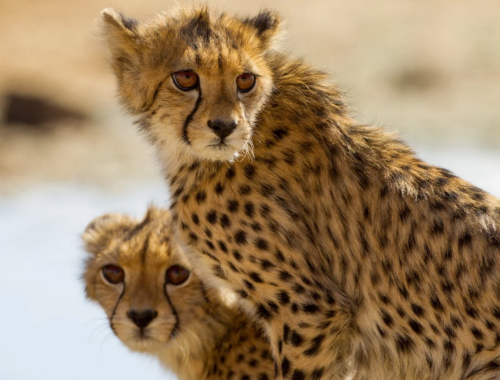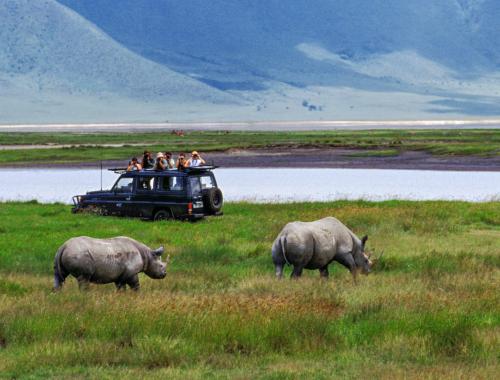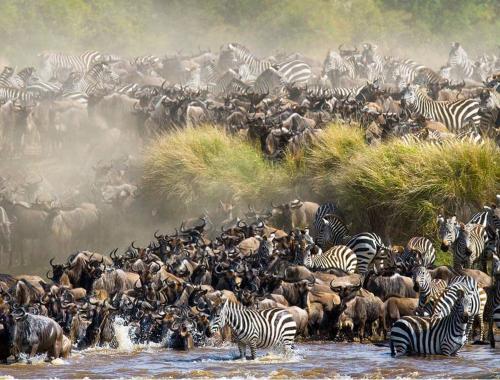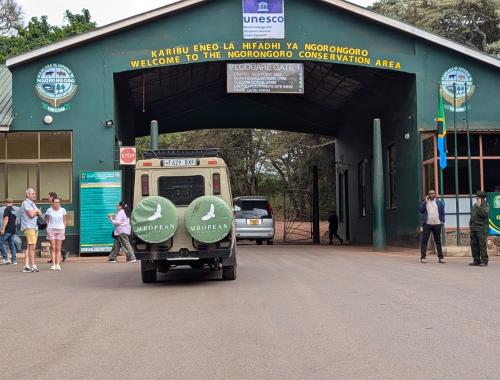Migration Safari
The Wildebeest Migration, also known as the Great Migration, is one of the most spectacular wildlife events on the planet. Each year, over 1.5 million wildebeest, joined by hundreds of thousands of zebras and gazelles, embark on a perilous journey through the Serengeti in Tanzania and the Maasai Mara in Kenya. This circular migration is driven by the search for fresh grazing lands and water, creating a dynamic and continuous movement across the plains.
The migration is not only a breathtaking spectacle but also plays a crucial role in maintaining the ecosystem's balance.
Key Information on the Great Wildebeest Migration
| Fact | Details |
|---|---|
| Largest Migration | Nearly 2 million animals participate each year |
| Main Participants | Wildebeests, along with zebras, topi, gazelles, and others |
| Migration Period | December to November, depending on the rainy season |
| Distance Covered | About 1,000 kilometers during the migration cycle |
| Calving Season | 500,000 calves born in February, 8,000 daily |
| Migration Beginnings | Dates back to the 1960s |
| Predator Loss | Up to 250,000 wildebeests are killed by predators |
| Herd Size | Wildebeests divide into herds of hundreds of thousands |
Reason for Wildebeest Migration
During the calving season, over 500,000 calves are born within a short period, attracting predators. The migration follows rain patterns, moving to areas with fresh grazing and water. The Mara River crossings are one of the most dramatic parts, where wildebeest face crocodile attacks and dangerous currents.
The migration is vital for the ecosystem, as the herds help control grass growth, maintaining the balance of the Serengeti's vegetation. As they graze, they fertilize the land, promoting plant growth. This dynamic journey involves survival challenges, including encounters with predators and harsh conditions, but only the fittest wildebeest complete the journey.
Ultimately, the Great Migration is a cycle of life, where birth, survival, and death sustain the Serengeti's ecosystem, symbolizing the resilience of nature.
Best Time to See the Great Wildebeest Migration in Tanzania?
Here's a table outlining the best times to see the Great Wildebeest Migration in Tanzania:
| Time Period | Location/Activity | Highlights |
|---|---|---|
| January to February | Southern Serengeti (Ndutu) | Calving season – Over 500,000 wildebeest calves are born, attracting predators. Great for newborns and predator action. |
| June to July | Western Corridor, Serengeti | Migration moves northward, with herds traveling through the Western Corridor. A great time to see the herds in action. |
| August to September | Mara River (Northern Serengeti and Maasai Mara) | Mara River crossings – Wildebeest face crocodiles and strong currents. One of the most dramatic and popular events. |
| October to November | Northern Serengeti and Maasai Mara | The herds begin their return journey south. Excellent wildlife viewing as the migration continues. |
Best Locations to Experience the Great Wildebeest Migration in Tanzania
The Great Wildebeest Migration is one of the most amazing wildlife events in the world. It involves millions of wildebeests, zebras, and gazelles moving in search of food and water across vast areas of Tanzania and Kenya. Here’s a simple explanation of the best places to see this migration in Tanzania
1. Serengeti National Park
What happens: The Serengeti is the main place to see the migration. The wildebeests travel through this park all year round, but the most exciting parts happen at different times of the year.
Best time to visit:
- July to October: The wildebeests try to cross the Mara River in the northern part of the Serengeti, which is one of the most dramatic parts of the migration.
- December to March: This is when many wildebeests give birth to their babies in the southern Serengeti.
Why visit: The Serengeti offers a chance to see huge herds of wildebeests and zebras moving across the plains. The river crossings in the northern Serengeti are especially thrilling.
2. Ngorongoro Conservation Area
What happens: The Ngorongoro Crater is another great place to see the migration. It’s not the main route for the wildebeests, but they pass through this area looking for food and water.
Best time to visit: November to April – During the rainy season, the herds move closer to Ngorongoro to find fresh grass.
Why visit: The Ngorongoro Crater is a beautiful place, and it’s easier to spot animals here because the area is smaller. You can see wildebeests along with other animals like lions, elephants, and buffaloes.
3. Northern Serengeti (Kogatende and Lamai Wedge)
What happens: This is the area where the wildebeests try to cross the Mara River. This is one of the most exciting parts of the migration because the animals face dangers like crocodiles and strong currents while crossing the river.
Best time to visit: July to October – This is when the wildebeests are trying to cross the Mara River in huge numbers.
Why visit: It’s the best place to witness the dramatic river crossings, where wildebeests risk their lives to reach the other side. It’s an unforgettable moment of nature.
4. Southern Serengeti (Ndutu Area)
What happens: The southern Serengeti is where the wildebeests give birth to their calves. During this time, the plains are full of newborn wildebeests, and predators like lions, cheetahs, and hyenas are often nearby looking for a meal.
Best time to visit: December to March – This is calving season when the wildebeests give birth.
Why visit: This is the best time to see many baby wildebeests, and the predator-prey interactions are incredible. It’s also the best time to see large herds in one place.
5. Western Serengeti (Grumeti River)
What happens: The wildebeests cross the Grumeti River in the western Serengeti before heading north to the Mara River. Just like at the Mara River, the crossing here is filled with danger, as crocodiles wait in the water.
Best time to visit: May to June – The wildebeests are in the western Serengeti at this time, before they start their journey north.
Why visit: The Grumeti River crossing is another exciting moment of the migration, and you can see crocodiles trying to catch the wildebeests as they cross.
Great Wildebeest Migration is a once-in-a-lifetime experience that showcases the beauty and drama of nature. Tanzania offers some of the best locations to witness this incredible event, from the thrilling Mara River crossings in the north to the heartwarming calving season in the south. Whether you’re looking to see millions of animals moving across vast plains, newborn wildebeests, or predators hunting, each part of the migration offers something special. The best time to visit depends on the specific part of the migration you want to see, but no matter when you go, it will be a truly unforgettable adventure.




